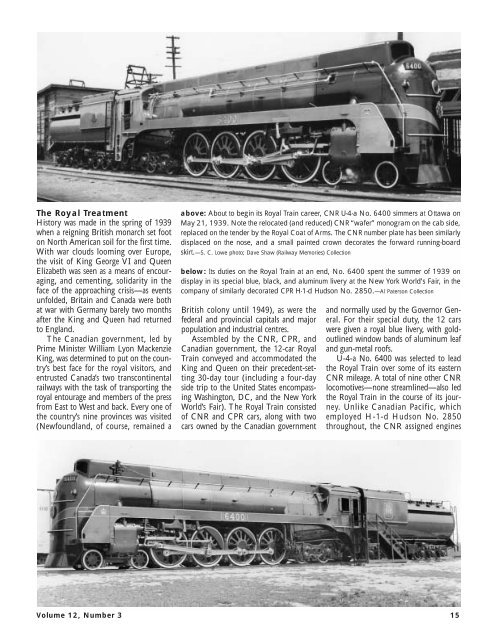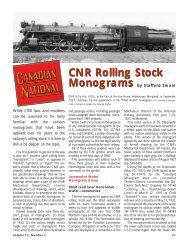CN LINES V12N3 - Canadian National Railways Historical Association
CN LINES V12N3 - Canadian National Railways Historical Association
CN LINES V12N3 - Canadian National Railways Historical Association
Create successful ePaper yourself
Turn your PDF publications into a flip-book with our unique Google optimized e-Paper software.
The Royal Treatment<br />
History was made in the spring of 1939<br />
when a reigning British monarch set foot<br />
on North American soil for the first time.<br />
With war clouds looming over Europe,<br />
the visit of King George VI and Queen<br />
Elizabeth was seen as a means of encouraging,<br />
and cementing, solidarity in the<br />
face of the approaching crisis—as events<br />
unfolded, Britain and Canada were both<br />
at war with Germany barely two months<br />
after the King and Queen had returned<br />
to England.<br />
The <strong>Canadian</strong> government, led by<br />
Prime Minister William Lyon Mackenzie<br />
King, was determined to put on the country’s<br />
best face for the royal visitors, and<br />
entrusted Canada’s two transcontinental<br />
railways with the task of transporting the<br />
royal entourage and members of the press<br />
from East to West and back. Every one of<br />
the country’s nine provinces was visited<br />
(Newfoundland, of course, remained a<br />
above: About to begin its Royal Train career, <strong>CN</strong>R U-4-a No. 6400 simmers at Ottawa on<br />
May 21, 1939. Note the relocated (and reduced) <strong>CN</strong>R “wafer” monogram on the cab side,<br />
replaced on the tender by the Royal Coat of Arms. The <strong>CN</strong>R number plate has been similarly<br />
displaced on the nose, and a small painted crown decorates the forward running-board<br />
skirt.—S. C. Lowe photo; Dave Shaw (Railway Memories) Collection<br />
below: Its duties on the Royal Train at an end, No. 6400 spent the summer of 1939 on<br />
display in its special blue, black, and aluminum livery at the New York World’s Fair, in the<br />
company of similarly decorated CPR H-1-d Hudson No. 2850.—Al Paterson Collection<br />
British colony until 1949), as were the<br />
federal and provincial capitals and major<br />
population and industrial centres.<br />
Assembled by the <strong>CN</strong>R, CPR, and<br />
<strong>Canadian</strong> government, the 12-car Royal<br />
Train conveyed and accommodated the<br />
King and Queen on their precedent-setting<br />
30-day tour (including a four-day<br />
side trip to the United States encompassing<br />
Washington, DC, and the New York<br />
World’s Fair). The Royal Train consisted<br />
of <strong>CN</strong>R and CPR cars, along with two<br />
cars owned by the <strong>Canadian</strong> government<br />
and normally used by the Governor General.<br />
For their special duty, the 12 cars<br />
were given a royal blue livery, with goldoutlined<br />
window bands of aluminum leaf<br />
and gun-metal roofs.<br />
U-4-a No. 6400 was selected to lead<br />
the Royal Train over some of its eastern<br />
<strong>CN</strong>R mileage. A total of nine other <strong>CN</strong>R<br />
locomotives—none streamlined—also led<br />
the Royal Train in the course of its journey.<br />
Unlike <strong>Canadian</strong> Pacific, which<br />
employed H-1-d Hudson No. 2850<br />
throughout, the <strong>CN</strong>R assigned engines<br />
Volume 12, Number 3 15



